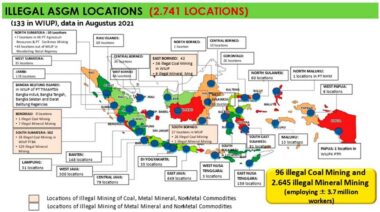 Indonesia, a sprawling archipelago of over 17,000 islands, holds a unique position in the global gold mining landscape. With vast mineral reserves and a spectrum of extraction practices—from advanced industrial operations to informal artisanal mining—the country stands at the intersection of opportunity and urgent environmental responsibility.
Indonesia, a sprawling archipelago of over 17,000 islands, holds a unique position in the global gold mining landscape. With vast mineral reserves and a spectrum of extraction practices—from advanced industrial operations to informal artisanal mining—the country stands at the intersection of opportunity and urgent environmental responsibility.
Major Gold Mining Operations
• Grasberg (Central Papua): One of the world’s largest gold and copper mines, operated by PT Freeport Indonesia, a joint venture between Freeport-McMoRan and the Indonesian government. The site includes massive underground facilities like Grasberg Block Cave. In 2023, it produced approximately 1.7 million ounces of gold.
• Batu Hijau (Sumbawa Island): An open-pit mine operated by PT Amman Mineral Nusa Tenggara. In 2023, it yielded about 448,950 ounces of gold.
• Tujuh Bukit (East Java): Operated by PT Merdeka Copper Gold, this mine is expected to produce between 100,000 and 120,000 ounces in 2024.
• Martabe (North Sumatra): Managed by PT Agincourt Resources, this mine has produced over 200,000 ounces of gold annually since it began commercial operations in 2012.
Artisanal and Small-Scale Gold Mining (ASGM)
Indonesia also hosts a vast ASGM sector, with an estimated 300,000–500,000 individuals involved. While this sector supports many rural economies, its heavy use of mercury poses serious environmental and health risks. The planetGOLD initiative is actively working to transition these operations to mercury-free technologies and formalize the sector.
National Strategy and Sustainability
In February 2025, President Prabowo Subianto launched Indonesia’s first state-backed gold bullion banks—Pegadaian and Bank Syariah Indonesia—aimed at retaining gold reserves domestically and supporting a vertically integrated gold industry.
Furthermore, a new $3.7 billion smelting facility operated by Freeport Indonesia began operations in East Java in late 2024, capable of refining up to 50 tons of gold annually alongside copper output.
Environmental and Social Concerns
Despite the economic benefits, Indonesia’s gold mining industry faces considerable environmental and safety challenges. In July 2024, a deadly landslide at an illegal gold mine in Gorontalo province claimed at least a dozen lives, highlighting the urgent need for improved oversight and worker safety.
